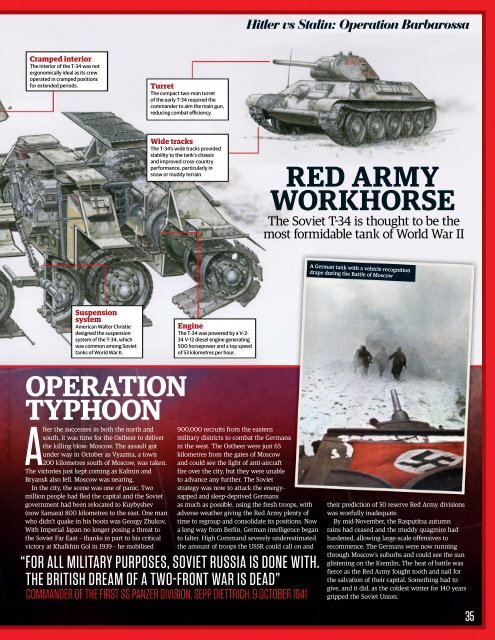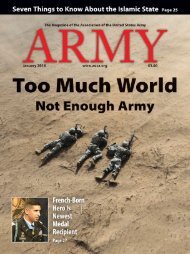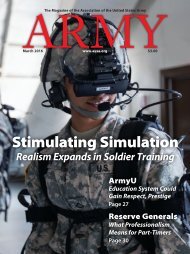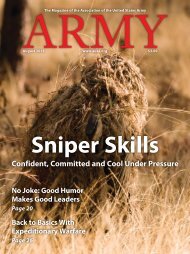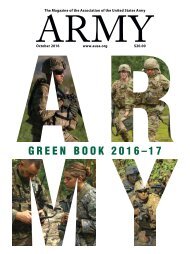All About - History - Hitler Versus Stain
All About History offers a energizing and entertaining alternative to the academic style of existing titles. The key focus of All About History is to tell the wonderful, fascinating and engrossing stories that make up the world’s history.
All About History offers a energizing and entertaining alternative to the academic style of existing titles. The key focus of All About History is to tell the wonderful, fascinating and engrossing stories that make up the world’s history.
Create successful ePaper yourself
Turn your PDF publications into a flip-book with our unique Google optimized e-Paper software.
<strong>Hitler</strong> vs Stalin: Operation Barbarossa<br />
Cramped interior<br />
The interior of the T-34 was not<br />
ergonomically ideal as its crew<br />
operated in cramped positions<br />
for extended periods.<br />
Turret<br />
The compact two-man turret<br />
of the early T-34 required the<br />
commander to aim the main gun,<br />
reducing combat efficiency.<br />
Wide tracks<br />
The T-34’s wide tracks provided<br />
stability to the tank’s chassis<br />
and improved cross-country<br />
performance, particularly in<br />
snow or muddy terrain.<br />
RED ARMY<br />
WORKHORSE<br />
The Soviet T-34 is thought to be the<br />
most formidable tank of World War II<br />
A German tank with a vehicle recognition<br />
drape during the Battle of Moscow<br />
Suspension<br />
system<br />
American Walter Christie<br />
designed the suspension<br />
system of the T-34, which<br />
was common among Soviet<br />
tanks of World War II.<br />
Engine<br />
The T-34 was powered by a V-2-<br />
34 V-12 diesel engine generating<br />
500 horsepower and a top speed<br />
of 53 kilometres per hour.<br />
OPERATION<br />
TYPHOON<br />
After the successes in both the north and<br />
south, it was time for the Ostheer to deliver<br />
the killing blow: Moscow. The assault got<br />
under way in October as Vyazma, a town<br />
200 kilometres south of Moscow, was taken.<br />
The victories just kept coming as Kalinin and<br />
Bryansk also fell. Moscow was nearing.<br />
In the city, the scene was one of panic. Two<br />
million people had fled the capital and the Soviet<br />
government had been relocated to Kuybyshev<br />
(now Samara) 800 kilometres to the east. One man<br />
who didn’t quake in his boots was Georgy Zhukov.<br />
With Imperial Japan no longer posing a threat to<br />
the Soviet Far East – thanks in part to his critical<br />
victory at Khalkhin Gol in 1939 – he mobilised<br />
900,000 recruits from the eastern<br />
military districts to combat the Germans<br />
in the west. The Ostheer were just 65<br />
kilometres from the gates of Moscow<br />
and could see the light of anti-aircraft<br />
fire over the city, but they were unable<br />
to advance any further. The Soviet<br />
strategy was now to attack the energysapped<br />
and sleep-deprived Germans<br />
as much as possible, using the fresh troops, with<br />
adverse weather giving the Red Army plenty of<br />
time to regroup and consolidate its positions. Now<br />
a long way from Berlin, German intelligence began<br />
to falter. High Command severely underestimated<br />
the amount of troops the USSR could call on and<br />
“ FOR ALL MILITARY PURPOSES, SOVIET RUSSIA IS DONE WITH.<br />
THE BRITISH DREAM OF A TWO-FRONT WAR IS DEAD”<br />
COMMANDER OF THE FIRST SS PANZER DIVISION, SEPP DIETTRICH, 9 OCTOBER 1941<br />
their prediction of 50 reserve Red Army divisions<br />
was woefully inadequate.<br />
By mid-November, the Rasputitsa autumn<br />
rains had ceased and the muddy quagmire had<br />
hardened, allowing large-scale offensives to<br />
recommence. The Germans were now running<br />
through Moscow’s suburbs and could see the sun<br />
glistening on the Kremlin. The heat of battle was<br />
fierce as the Red Army fought tooth and nail for<br />
the salvation of their capital. Something had to<br />
give, and it did, as the coldest winter for 140 years<br />
gripped the Soviet Union.<br />
35


